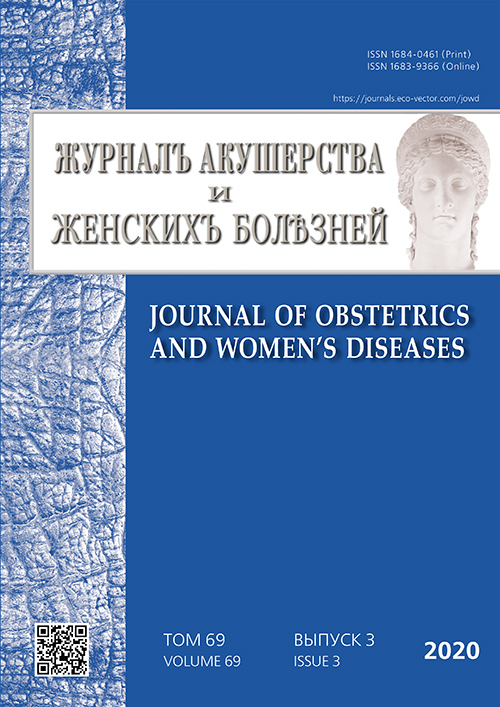Comprehensive assessment of the pelvic floor in women: new approaches to the prediction of pelvic organ prolapse
- Authors: Musin I.I.1
-
Affiliations:
- Bashkir State Medical University of the Ministry of Health of the Russian Federation
- Issue: Vol 69, No 3 (2020)
- Pages: 13-16
- Section: Original study articles
- URL: https://bakhtiniada.ru/jowd/article/view/42289
- DOI: https://doi.org/10.17816/JOWD69313-16
- ID: 42289
Cite item
Abstract
Hypothesis/aims of study. Despite the growing prevalence of pelvic floor dysfunction in women in the postpartum period, there is still no consensus on its etiology and pathogenesis. The prerequisite for serious disorders to occur in the future is the initial stages of pelvic floor dysfunction after childbirth, despite the fact that they occur without severe symptoms and, remaining undiagnosed in a timely manner, further reduce the quality of life of women. Despite the availability of information on causal relationships between childbirth and the appearance of pelvic floor dysfunctions, this knowledge among women of reproductive age is still limited, which warrants further study. A number of methods have been developed to assess the pelvic floor, among which are non-invasive techniques, including a quantitative assessment of the strength of contractions of the pelvic floor muscles, as well as techniques that assess the microcirculation of the vaginal wall. The aim of this study was to evaluate the parameters of the strength of contractions of the pelvic floor muscles and to identify possible correlations between the obtained parameters.
Study design, materials and methods. The study was carried out using methods for measuring the blood microcirculation of the vaginal wall using laser Doppler blood flowmetry in women after the first birth.
Results. We obtained indicators of the strength of contractions of the pelvic floor muscles and indicators of the blood microcirculation of the vaginal wall in primary women, and we revealed the dependence of the obtained indicators on the weight and age of the mother, as well as the weight of the fetus at birth.
Conclusion. The obtained indicators will allow a comprehensive assessment of the pelvic floor in primiparous women, as well as to identify possible risk groups for genital prolapse development in the future.
Full Text
##article.viewOnOriginalSite##About the authors
Ilnur I. Musin
Bashkir State Medical University of the Ministry of Health of the Russian Federation
Author for correspondence.
Email: info@eco-vector.com
ORCID iD: 0000-0001-5520-5845
MD, PhD, Assistant Professor. The Department of Obstetrics and Gynecology with the Institute of Continuing Education Course
Russian Federation, UfaReferences
- Акуленко Л.В., Касян Г.Р., Козлова Ю.О., и др. Дисфункция тазового дна у женщин в аспекте генетических исследований // Урология. − 2017. − № 1. − С. 76–81. [Akulenko LV, Kasyan GR, Kozlova YuO, et al. Female pelvic floor dysfunction from the perspectives of genetic studies. Urologiya. 2017;(1):76-81. (In Russ.)]. https://doi.org/10.18565/urol.2017.1.76-81.
- Кочев Д.М., Дикке Г.Б. Дисфункция тазового дна до и после родов и превентивные стратегии в акушерской практике // Акушерство и гинекология. − 2017. − № 5. − С. 9–15. [Kochev DM, Dikke GB. Pelvic floor dysfunction before and after childbirth and preventive strategies in obstetric practice. Obstetrics and gynecology. 2017;(5) 9-15. (In Russ.)]. https://doi.org/10.18565/aig.2017.5.9-15.
- Ящук А.Г., Рахматуллина И.Р., Мусин И.И., и др. Тренировка мышц тазового дна по методу биологической обратной связи у первородящих женщин после вагинальных родов // Медицинский вестник Башкортостана. − 2018. − Т. 13. − № 4. − С. 17−22. [Yashchuk AG, Rakhmatullina IR, Musin II, et al. Pelvic floor muscles trai¬ning by the method of biological feedback in primigravidas after vaginal delivery. Meditsinskiy vestnik Bashkortostana. 2018;13(4):17-22. (In Russ.)]
- Дикке Г.Б., Кучерявая Ю.Г., Суханов А.А., и др. Современные методы оценки функции и силы мышц тазового дна у женщин // Медицинский алфавит. − 2019. − Т. 1. − № 1. − С. 80–85. [Dikke GB, Kucheryavaya YuG, Sukhanov AA, et al. Modern methods of assessing function and strength ofpelvic muscles in women. Meditsinskiy alfavit. 2019;1(1):80-85. (In Russ.)]. https://doi.org/10.33667/2078-5631-2019-1-1(376)-80-85.
- Мусин И.И., Камалова К.А. Применение метода лазерной допплеровской флоуметрии для оценки состояния микроциркуляции тазового дна у женщин // Российский вестник акушера-гинеколога. − 2018. − Т. 18. − № 6. − С. 58–61. [Musin II, Kamalova KA. Laser Doppler flowmetry for pelvic floor microcirculatory assessment in women. Rossiyskiy vestnik akushera-ginekologa. 2018;18(6):58-61. (In Russ.)]. https://doi.org/10.17116/rosakush20181806158.
- Артымук Н.В., Хапачева С.Ю. Распространенность симптомов дисфункции тазового дна у женщин репродуктивного возраста // Акушерство и гинекология. − 2018. − № 9. − С. 99–104. [Artymuk NV, Khapacheva SYu. The prevalence of pelvic floor dysfunction symptoms in reproductive-aged women. Obstetrics and gynecology. 2018;(9):99-104. (In Russ.)]. https://doi.org/10.18565/aig.2018.9.99-105.
- Rostaminia G, Javadiann P, O’boyle A. Parity and pelvic floor dysfunction symptoms during pregnancy and early postpartum. Pelviperineology. 2017;36:48-52.
- Durnea CM, Khashan AS, Kenny LC, et al. What is to blame for postnatal pelvic floor dysfunction in primiparous women-Pre-pregnancy or intrapartum risk factors? Eur J Obstet Gynecol Reprod Biol. 2017;214:36-43. https://doi.org/10.1016/j.ejogrb.2017.04.036.
- Bodner-Adler B, Kimberger O, Laml T, et al. Prevalence and risk factors for pelvic floor disorders during early and late pregnancy in a cohort of Austrian women. Arch Gynecol Obstet. 2019;300(5):1325-1330. https://doi.org/10.1007/s00404-019-05311-9.
Supplementary files







